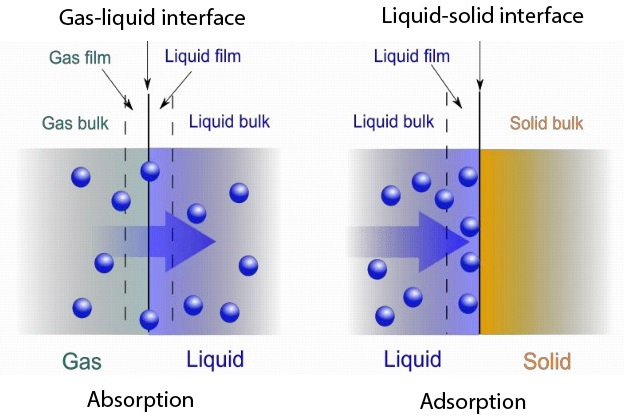Absorption and adsorption are two closely related but distinct processes that involve the uptake of one substance by another. Absorption is the process in which a substance is taken in by another substance through chemical reactions or physical processes, such as diffusion or osmosis. This process results in a homogenous mixture, with the absorbed substance becoming a part of the absorbing substance.
On the other hand, adsorption is the process in which a substance is taken in by the surface of another substance through a process of attraction between the surface of the adsorbent and the adsorbate. This process results in a heterogeneous mixture, with the adsorbate remaining physically separate from the adsorbent.
Some common examples of absorption include plants absorbing carbon dioxide during photosynthesis, water is absorbed by a sponge, and a liquid being absorbed by a porous material. On the other hand, some common examples of adsorption include water being removed from the air by a desiccant, gases and liquids being separated by using adsorbent materials like activated carbon, and water purification by using adsorbent materials like sand or gravel.
Both Absorption and Adsorption are widely used in various industrial and environmental applications such as air and water purification, waste management, and the production of chemicals and fuels. They also play an important role in the field of chromatography for the separation and purification of different chemical compounds. In addition, they are also used in the production of medicinal drugs, catalysts, and many other products. Due to their ability to bind and separate specific molecules, they are also utilized in industries like chemical and pharmaceuticals as well as in environmental remediation. They can also be used in adsorption chillers, which are highly efficient and eco-friendly technology for air conditioning.
In fact, the process of absorption and adsorption is not limited to industrial and environmental applications. It also finds its usage in everyday life. For example, in the form of water filter pitchers, where activated carbon is used to adsorb impurities and chlorine from tap water. Similarly, in the form of air purifiers, where activated carbon or zeolites are used to adsorb pollutants and odors from the air.
In conclusion, Absorption and Adsorption are two versatile processes that have wide-ranging applications in various fields. They are not only used in industrial and environmental applications but also find their usage in everyday life. Their ability to bind and separate specific molecules makes them an essential tool in various industries and technologies.

